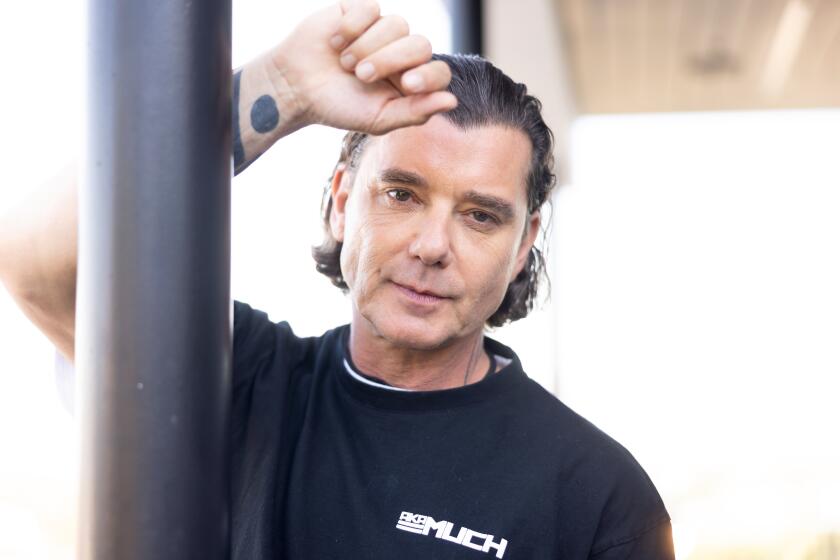L.A. Philharmonic’s Mr. Versatility
- Share via
Angelenos are understandably proud of Miguel Harth-Bedoya.
We watched him win over the Los Angeles Philharmonic and its audiences, and rise from assistant to associate conductor, his current post. But as important as the orchestra has been to him, he has actually made his career elsewhere.
For the record:
12:00 a.m. April 3, 2002 FOR THE RECORD
Los Angeles Times Wednesday April 3, 2002 Home Edition Main News Part A Page 2 A2 Desk 2 inches; 45 words Type of Material: Correction
Philharmonic work--A review of the Los Angeles Philharmonic in Saturday’s Calendar mistakenly gave the impression that the work described as a vehicle for percussionist Evelyn Glennie was John Harbison’s “The Most Often Used Chords.” In fact, the work being referred to was Joseph Schwantner’s “Percussion Concerto.”
In addition to his Philharmonic post, he is music director of three orchestras--in Eugene, Ore. (where it is his last season); Fort Worth, Texas (his first season); and Auckland, New Zealand. Now his name is starting to be mentioned for the next level of orchestra, such as the New Jersey Symphony, which is searching for a music director. He is increasingly popular as a guest conductor for opera companies and symphony orchestras in America and abroad.
As a result, Harth-Bedoya’s local appearances have the quality of snapshots of his artistic growth. Sometimes those appearances with the Philharmonic have seemed a bit too glossy, too posed. He has an undeniable flair for lightweight, colorful repertory. But his association with it also presents the danger of typecasting.
That was not the case Thursday night with the Philharmonic. His program at the Dorothy Chandler Pavilion may not have been the weightiest imaginable, but it demonstrated scope, substance and imagination by containing two works by Pulitzer Prize-winning American composers--John Harbison and Joseph Schwantner--along with Dvorak’s Seventh Symphony. All three pieces called for color, especially Schwantner’s Percussion Concerto, for which Evelyn Glennie was soloist.
But there’s more to them than that. Indeed, the Dvorak symphony is exactly the kind of repertory work that can show the direction of Harth-Bedoya’s development. This is the first great Dvorak symphony (although some think that the Sixth is). Written in D minor, it is darker and more dramatic than the two symphonies that followed. It is also Dvorak’s most nationalistic symphony, with its subtext of Czech patriotism and anti-Hapsburg sentiment. Conductors often compete to see who can wring the most fervor from it.
Harth-Bedoya, however, didn’t so much wring as ring. The essential character of his performance was buoyancy and momentum. The opening, a characterization of a nationalist rally at a Prague train station, was less fervent or furious than propulsive. Harth-Bedoya thrust the symphony forth, like a blast-off, enjoying the lift and then, in the lyrical second theme, basked in the floating lyricism. And throughout the four movements, there was always the sense the dramatic intensity and vibrant energy were there not for their own sake but to release something else.
It is fresh and unusual to hear this work as a rendering of growth and bloom, but not everything seemed tight. Harth-Bedoya stopped, ever enticingly, to smell the flowers, and sometimes he seemed to wander slightly in the slow movement and the Finale. But he never lingered too long, and he always picked up his step when he needed to. The dance-lilt of the Scherzo was a pure joy. Best of all, this is Harth-Bedoya’s Dvorak and no one else’s.
Both the American pieces were written in the early ‘90s. Harbison, who was the Philharmonic’s composer in residence in the ‘80s, has been unjustly neglected since, so it was a doubly nice gesture to revive his “The Most Often Used Chords,” given that it was composed for the Los Angeles Chamber Orchestra. That said, this enjoyable piece, which cleverly plays around with elementary tonal devices, came off as a bit stiff, in part, perhaps, because it was played by a slightly too large band (somewhere between chamber orchestra and full-sized one).
Though not written for Glennie, it has become her vehicle, and she made quite a spectacle of it. The composer, from Chicago, originally made a name for himself with precious, quiet music, exquisitely colored. His showier, more obvious side, which this concerto reveals, is less interesting, but his color sense doesn’t fail him.
And there is certainly enough going on to keep Glennie excitingly busy. She was in her element, dashing barefoot among instruments (set up in front of the orchestra and behind it). Glennie and Harth-Bedoya share a gift for rhythmic onslaught and relish color, and together, they made a harmless concerto into tonal theater and an audience happy.
*
The Los Angeles Philharmonic repeats this program tonight at 8, $12-$78, Dorothy Chandler Pavilion, 135 N. Grand Ave. (213) 850-2000.
More to Read
The biggest entertainment stories
Get our big stories about Hollywood, film, television, music, arts, culture and more right in your inbox as soon as they publish.
You may occasionally receive promotional content from the Los Angeles Times.











